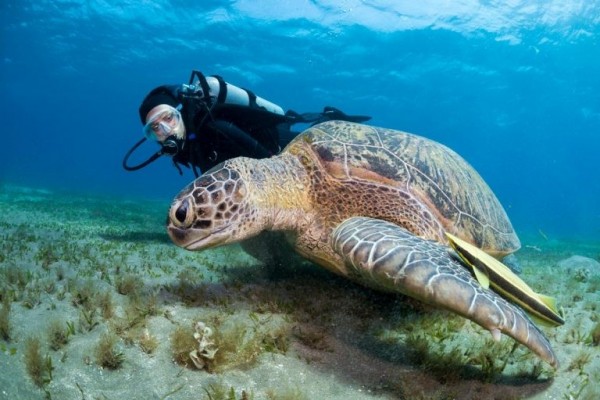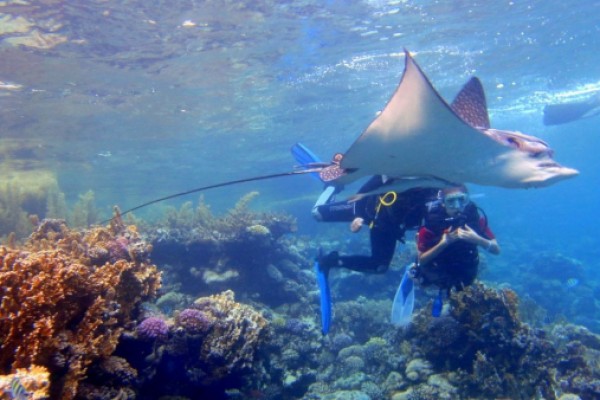RAS MOHAMED NATIONAL PARK
RAS MOHAMED NATIONAL PARK
Description
It is one of the most popular dive spots on the Red Sea. It has a teeming marine life with beautiful soft coral. You will enjoy relaxing drift dives along beautiful walls. Watch also the blue to spot the pelagic fishes like Barracudas and Trevallies swimming by! You can also spot their Whitetip Reef Sharks and very rarely the Hammerhead Shark.
RAS MOHAMED National Park dive sites:
- Ras Ghozlani
- Marsa Bareka
- Ras Zatar
- Jackfish Alley
- Eel Garden
- Shark Observatory
- Anemone city
- Shark & Yolanda Reefs.
South of Sharm el Sheikh the coast is totally deserted, with no shelter for more than a mile, up to the small bay named MARSA GHOZLANI, where the Ras Mohamed National Park begins. It is followed by another bay, MARSA BAREKA which is much larger and deeper.
Because of its geographic position the Ras Mohammed peninsula is a privileged area that benefits from currents that transport large quantities of plankton and other food that give rise to an extraordinary growth of hard and soft corals and attract large schools of both reef and pelagic marine fauna. It’s offering divers the chance to make extremely interesting and exciting dives.
Jackfish Alley
The name of this site derives from the white sandy road between the coral ledge bordering the coast and a parallel satellite reef that is often frequented by Jackfish.
The beginning of the drift dive is easy to spot owing to the white mark on the cliff. After descending to 6 meters, you will immediately see the large entrance to the first cave, which penetrates the reef for about 40 meters and from which you exit, keeping to your left at a depth of 9 meters. Proceeding to the southwest with the reef on your right, you will come to a large coral outcrop beyond which, at 14 meters, there is another cave that runs upwards and has a wide exit hole at 6 meters. This is the home of a myriad of glassfish (Pigmy sweepers, Parapriacanthus ransonnett). A little further south there is a sandy bay that must be crossed in a southwest direction in order to see, at a depth of Il meters, another coral outcrop swarming with life and populated by another colony of glassfish. From here continue to proceed southwest and, once past a zone rich in madrepores, at a depth of 18–20 meters you will be at the sandy ‘alley’ this site is named after. Whitetip reef sharks (Triaenodon obesus) and Manta rays (Manta birostris) as well as jackfish (genus Caranx), Blue triggerfish (Pseudobalistes fuscus), and Bluespotted stingrays (Taeniura lymma) have often been spotted in this area.
Shark Observatory
This name indicates not only the first balcony on the top of the Ras Mohammed promontory but also the diving site that is on a level with that promontory. This is a magnificent wall dive, also known as the Ras Mohammed Wall: while looking down into the deep blue, you can admire a grandiose environment and at the same time see large pelagic predators (even some Whale sharks have been seen in this area time and again). After descending for about 15 meters, you can explore the wall on your left, which is rich in Alcyonarians, gullies, shelters, and caves swarming with life, without losing sight of the blue, from which Jackfish, barracuda, and some sharks might suddenly appear.
Shark & Yolanda Reef
It is the most famous and popular dive in Ras Mohamed National Park. A world-ranked dive site formed of two little underwater islands, the Shark reef, and the Yolanda reef. Shark Reef, is a vertical wall dropping to 700 meters, covered with fantastic corals. While the Yolanda Reef has a wide plateau with a coral garden and lots of pinnacle corals. Between the Yolanda reef and the Ras Mohamed reef lies the remains of the wreck of the Yolanda which is 74m long and was carrying bathroom supplies heading to the Gulf of Aqaba when she crashed in 1980. The presence of currents is often at this site. Diverse marine life to watch scorpionfish, crocodile fish, groupers, turtles, tuna, big morays and napoleon fish, Red Snapper, batfish, unicornfish, barracudas, and more.
 -
-
 -
-
 -
-




